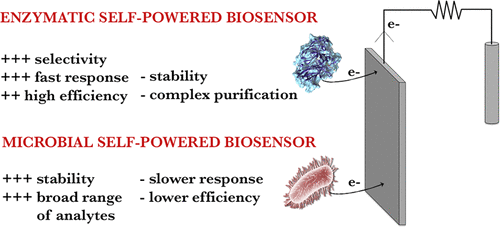Our official English website, www.x-mol.net, welcomes your feedback! (Note: you will need to create a separate account there.)
Self-Powered Biosensors
ACS Sensors ( IF 8.9 ) Pub Date : 2017-12-05 00:00:00 , DOI: 10.1021/acssensors.7b00818 Matteo Grattieri 1 , Shelley D. Minteer 1
ACS Sensors ( IF 8.9 ) Pub Date : 2017-12-05 00:00:00 , DOI: 10.1021/acssensors.7b00818 Matteo Grattieri 1 , Shelley D. Minteer 1
Affiliation

|
Self-powered electrochemical biosensors utilize biofuel cells as a simultaneous power source and biosensor, which simplifies the biosensor system, because it no longer requires a potentiostat, power for the potentiostat, and/or power for the signaling device. This review article is focused on detailing the advances in the field of self-powered biosensors and discussing their advantages and limitations compared to other types of electrochemical biosensors. The review will discuss self-powered biosensors formed from enzymatic biofuel cells, organelle-based biofuel cells, and microbial fuel cells. It also discusses the different mechanisms of sensing, including utilizing the analyte being the substrate/fuel for the biocatalyst, the analyte binding the biocatalyst to the electrode surface, the analyte being an inhibitor of the biocatalyst, the analyte resulting in the blocking of the bioelectrocatalytic response, the analyte reactivating the biocatalyst, Boolean logic gates, and combining affinity-based biorecognition elements with bioelectrocatalytic power generation. The final section of this review details areas of future investigation that are needed in the field, as well as problems that still need to be addressed by the field.
中文翻译:

自供电生物传感器
自供电的电化学生物传感器利用生物燃料电池作为同时的电源和生物传感器,这简化了生物传感器系统,因为它不再需要稳压器,稳压器的功率和/或信号装置的功率。本文的重点是详细介绍自供电生物传感器领域的进展,并讨论它们与其他类型的电化学生物传感器相比的优势和局限性。这篇综述将讨论由酶促生物燃料电池,基于细胞器的生物燃料电池和微生物燃料电池组成的自供电生物传感器。它还讨论了不同的传感机制,包括利用分析物作为生物催化剂的底物/燃料,分析物将生物催化剂结合到电极表面,分析物作为生物催化剂的抑制剂,分析物导致生物电催化反应的阻断,分析物重新激活生物催化剂,布尔逻辑门,并将基于亲和力的生物识别元件与生物电催化发电相结合。本文的最后一部分详细介绍了该领域将来需要进行调查的领域,以及该领域仍需解决的问题。
更新日期:2017-12-05
中文翻译:

自供电生物传感器
自供电的电化学生物传感器利用生物燃料电池作为同时的电源和生物传感器,这简化了生物传感器系统,因为它不再需要稳压器,稳压器的功率和/或信号装置的功率。本文的重点是详细介绍自供电生物传感器领域的进展,并讨论它们与其他类型的电化学生物传感器相比的优势和局限性。这篇综述将讨论由酶促生物燃料电池,基于细胞器的生物燃料电池和微生物燃料电池组成的自供电生物传感器。它还讨论了不同的传感机制,包括利用分析物作为生物催化剂的底物/燃料,分析物将生物催化剂结合到电极表面,分析物作为生物催化剂的抑制剂,分析物导致生物电催化反应的阻断,分析物重新激活生物催化剂,布尔逻辑门,并将基于亲和力的生物识别元件与生物电催化发电相结合。本文的最后一部分详细介绍了该领域将来需要进行调查的领域,以及该领域仍需解决的问题。


























 京公网安备 11010802027423号
京公网安备 11010802027423号